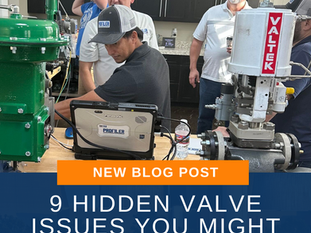top of page

In valve control systems, small pneumatic leaks can create major operational headaches. Loss of pressure, sluggish response, or erratic valve motion often trace back to hidden actuator leaks — and without the right tools, they’re nearly impossible to pinpoint.
SofTek’s Profiler Level 2 Testing gives engineers and technicians the data clarity needed to identify, locate, and quantify air leaks inside actuator assemblies. By capturing synchronized pressure, position, and command traces, Profiler provides a complete performance profile — exposing issues before they compromise valve integrity.
Recognizing the Warning Signs
When an actuator begins leaking air, the symptoms usually show up in one or more of these ways:
1. Audible or Visible Leaks
Increased air consumption or a constant hiss from the actuator housing indicates loss through seals or fittings.
Bubbles or discoloration around tubing connections confirm the escape path.
Rapid pressure decay with the valve closed signals sealing failure.
2. Erratic or Delayed Motion
Jerky, inconsistent movement points to pressure loss during actuation.
Lagging stroke response often means the actuator isn’t maintaining control pressure long enough to complete travel.
3. Degraded Valve Function
The valve may fail to fully open or close, causing position errors.
Long-term leaks increase cycle fatigue and wear on mechanical components.
How Profiler Level 2 Testing Detects Leaks
Profiler captures real-time performance curves — plotting actuator pressure, valve position, and control signal simultaneously. This gives technicians a diagnostic view that visual inspections can’t match.
Pressure Traces Reveal Hidden Losses Subtle pressure drops on the trace, despite steady command input, indicate internal or external leakage.
Response Lag and Stroke Irregularities Stand Out The Profiler graph clearly shows delayed motion or uneven acceleration caused by insufficient pressure.
Targeted, Real-Time Feedback Profiler highlights exactly where the performance deviates — allowing focused troubleshooting instead of hours of guesswork.
Think of it as a dynamic performance map that translates pneumatic behavior into measurable data.
What to Do When Profiler Flags a Leak
Once Profiler identifies probable leakage, follow a structured diagnostic approach:
Inspect and Replace Seals O-rings and diaphragms degrade over time — replacing them often restores full performance.
Tighten or Re-Seat Fittings Loose tubing or misaligned connectors can bleed pressure under load.
Evaluate Repair vs. Replacement Profiler data helps justify component replacement when leakage or wear exceeds acceptable limits.
Leverage Profiler Reports Detailed plots and performance metrics provide clear documentation for maintenance logs or manufacturer support.
Why It Matters
Unchecked leaks drain efficiency, accelerate wear, and disrupt process control. Profiler Level 2 testing eliminates uncertainty — providing technicians with quantifiable, visual proof of actuator health.
You’ll know what’s leaking, where it’s happening, and how it affects performance — before it becomes a failure.
Profiler Level 2: Data-driven diagnostics for proactive reliability.
Don’t guess. Just test it.
Related Posts
bottom of page








